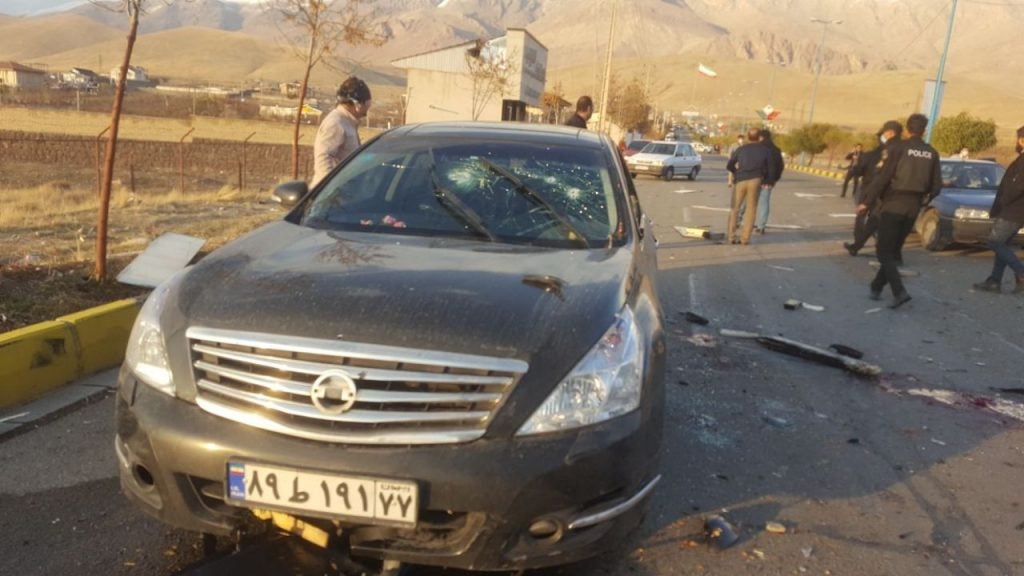Conflicting Narratives Of Assassination of Alleged Iranian Nuclear Mastermind
Iranian media reports now have generated two conflicting narratives regarding the assasination last Friday of an Iranian nuclear scientist long believed to have led Iran’s nuclear bomb program.
What is known for sure is that Mohsen Fakhrizadeh’s car was ambushed in the town of Absard, near the capital of Tehran. Following the attack, he was evacuated by helicopter to a hospital in Tehran for emergency surgery, but ultimately succumbed to his injuries.
The claims of how the ambush unfolded, however, are very different. In one account, a 12-man hit squad used a Hyundai Santa Fe SUV, a Nissan pickup truck rigged with explosives and four motorcycles to carry out the assasination. The Nissan pickup was parked on the expected path of Fakhrizadeh’s convoy, and was detonated to bring the convoy to a halt. The stopped convoy was then fired upon by the hit squad, with Fakhrizadeh dragged out of his car and shot to confirm his death. All 12 members made clean escapes.
In another, perhaps more lurid, account published by the Irna news agency, Fakhrizadeh was driving with his wife to spend their weekend at a weekend home in the suburbs of Tehran. After the lead car of his convoy broke off to secure his home, his car was brought to a halt after being shot at. Suspecting a collision with debris or mechanical failure, Fakhrizadeh exited the car only to be fired upon by a remotely controlled machine gun in the back of a Nissan pickup truck, with one of the three bullets that hit him severing his spine. A bodyguard was shot several times in a futile bid to shield Fakhrizadeh, the only other casualty of the ambush. Its mission successful, explosives in the pickup truck then detonated to remove any evidence of the contraption. According to Irna, nobody was on the ground to carry out the assassination, which took all of three minutes.
As the purported “Father of the Iranian Nuclear Bomb” Fakhrizadeh is no ordinary target, being the only Iranian scientist to have been named in the International Atomic Energy Agency’s “final assessment” of open questions regarding the Iranian nuclear weapon program in 2015. The report stated that he oversaw activities “in support of a possible military dimension to (Iran’s) nuclear programme” within the AMAD (Hope) Plan, the alleged codename for the Iranian nuclear weapon program that ran through the 1990s and early 2000s.
Israeli Prime Minister Binyamin Netenyahu named Fakhrizadeh as working on “special projects” for the Iranian Ministry of Defence in a 2018 presentation accusing Iran of continuing the development of nuclear weapons which saw the Prime Minister urging viewers to “remember that name”. Fakhrizadeh has long been on Mossad’s wanted list, being also a brigadier-general in the Islamic Revolutionary Guard Corps (IRGC).
Incidentally, the assasination comes just a day after the release of Kylie Moore-Gilbert, an Australian-British academic taken hostage by the Iranian government on espionage charges. She was released in exchange for the release of three Iranians imprisoned in Thailand for their involvement in a failed plot to assassinate Israeli diplomats in Bangkok, in retaliation for a Mossad assassination campaign against Iranian nuclear scientists 10 years ago.
Also on Wednesday, Axios reported that the Israel Defense Forces had been preparing for potential retaliation from Iran, over concerns of an American attack on Iran during “a very sensitive period” before the inauguration of President-elect Joe Biden on January 20. The scoop followed reporting from the New York Times last week that President Trump had considered a military attack on Iran’s uranium enrichment facility in Natanz during a meeting with senior members of his national security team. He allegedly decided against it after warnings from his national security team that it risked sparking a broader conflict during the final days of his presidency.
Furthermore, an Iranian-Belgian couple, an Iranian diplomat and another unidentified accomplice went on trial in Antwerp on Friday, for their role in a failed Iranian plot to bomb a Mujahedin-e-Khalq rally in France in 2018. The Iranian diplomat, Assadollah Assadi, did not appear, claiming diplomatic immunity through his lawyer. Two other people were also arrested for their involvement in the plot against the fringe Iranian opposition movement, with the French government accusing Iranian intelligence of being behind the failed bombing.
Iran’s Foreign Minister, Javad Zarif, accused Israel for the assassination of Fakhrizadeh on Friday, but did not provide any evidence. Chief of Staff of the Iranian Armed Forces, Mohammad Bagheri, has vowed “severe revenge” for the assassination of Fakhrizadeh as well. Peter Stano, the European Union’s Lead Spokesperson for Foreign Affairs and Security Policy, described the assassination as “a criminal act” that “runs counter to the principle of respect for human rights the EU stands for”.
With such a high profile target assassinated in such spectacular fashion, accusations of responsibility and apparent motives are being traded breathlessly. The Israeli government, Pentagon, and US Central Command have all refused comment on the assassination, leaving only wild and slightly less wild guessing to fill the void.

